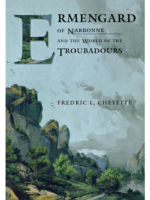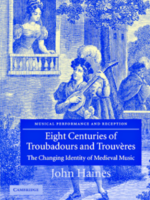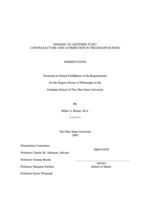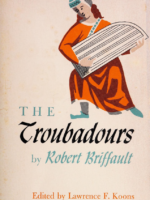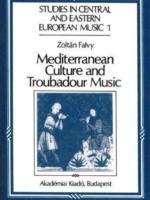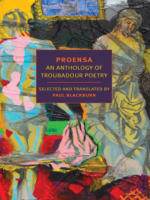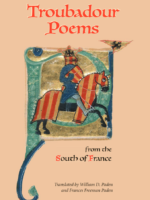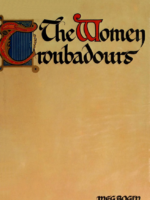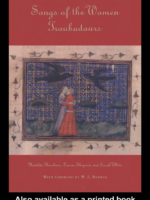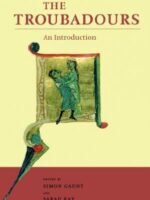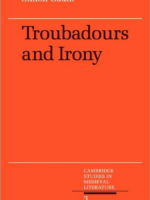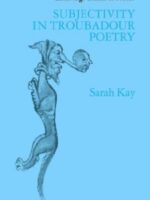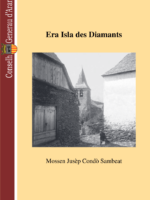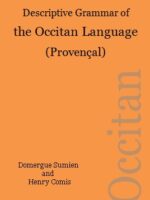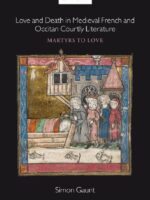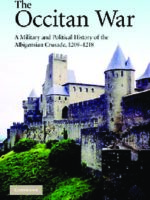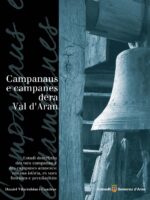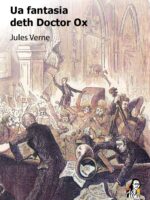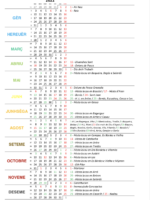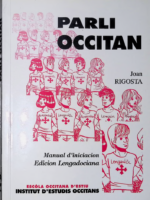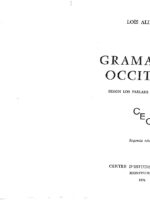-
Ermengard of Narbonne and the World of the Troubadours
0,00 €Ermengard of Narbonne. Even to specialists in the history of the Middle Ages her name is hardly known. Eleanor of Aquitaine, who was wife to two kings and the mother of three more? Yes, there is a name-and a story-to conjure with. Countess Marie of Champagne, Eleanor’s daughter by King Louis VII of France, patron of Chretien de Troyes, the poet who in- vented the Arthurian romance? She too is better known, if only because of the writers who thronged to her court. Ifwe know anything about the Middle Ages we have at least heard of King Richard the Lionheart and his brother King John, who was forced to grant the Magna Carta at Runnymede, both of them sons of Queen Eleanor. We have also surely heard of the mythical King Arthur and his Round Table, of Lancelot and Guinevere, of the quest for the Holy Grail, all of them largely the creation of Chretien. Ermengard, however, has fallen off the historical map.
-
Eight Centuries of Troubadours and Trouveres: The Changing Identity of Medieval Music
0,00 €From the medieval chansonniers to contemporary rap renditions, this book traces the changing interpretation of troubadour and trouv?re music, a repertoire of songs which have successfully maintained public interest for eight centuries. A study of their reception, therefore, serves to illustrate the development of the modern concept of “medieval music”. Important stages in their evolution include sixteenth-century antiquarianism; the Enlightenment synthesis of scholarly and popular traditions; and the infusion of archaeology and philology in the nineteenth century, leading to more recent theories on medieval rhythm.
-
Singing to another tune: contrafacture and attribution in troubadour song
0,00 €“Singing to another tune” is from Las Leys d’amors (The Laws of Love), a poetic treatise compiled by Guilhem Molinier in the first half of the fourteenth century. Guilhem’s phrase pertains to a compositional technique known to modern scholars as contrafacture, in which the troubadour fashions new lyrics after the poetic structure of a preexistent song, thereby allowing his work to be sung to the earlier melody. The technique of contrafacture is documented not only by Guilhem and contemporaneous theorists but also by the troubadours themselves, who on a number of occasions acknowledge composing a poem “el so de,” or “to the tune of” another composer. Both theory and practice demonstrate that structural imitation came to be most closely associated with several specific genres, including the sirventes (moralizing piece), tenso (debate song), coblas (song of few strophes), and planh (lament), their poetic structures commonly modeled after those of the canso, the dominant genre of troubadour composition. Despite abundant structural indications of contrafacture within the troubadour repertoire, melodic traces of the practice are surprisingly scant. Confirmation of melodic borrowing depends upon the preservation of a model and its contrafactum with their concordant musical readings, yet the small proportion of surviving troubadour melodies (with only one in ten lyric texts transmitted with its tune) poses a significant impediment to melodic corroboration. Only three sirventes have been preserved with melodies that duplicate those of preexistent cansos. In the remaining instances in which a sirventes, tenso, or other imitative type is preserved with a melodic unicum, scholars of troubadour song have tended to maintain that, absent melodic corroboration, the tune must be presumed original rather than borrowed. In view of the sparseness of the musical record, however, one should give consideration to an alternate interpretation, namely that the tune preserved exclusively with a given troubadour’s sirventes and thereafter transmitted as his invention may actually have been borrowed from a preexistent canso whose melody is no longer extant in its original setting. Isolating viable structural models for such suspected contrafacta allows the possibility of reascribing potentially borrowed melodies to their original composers. The study of contrafacture can thus lead us to question the received attributions of a number of tunes, thereby posing a challenge to the readily made assumption that the manuscript rubrics consistently pertain to both text and melody. By examining several suspected cases of contrafacture within a web of relevant indices– e.g., generic norms, intertextual correlations, socio-historic context, rhetorical motivation, transmission, and melodic style– we gain greater insight into a compositional technique that indelibly marked the art of the troubadours.
-
The Troubadours
0,00 €Combining extraordinary learning with grace of style, this volume provides the first comprehensive work in English on the poetic heritage of the medieval troubadours and the particular impact of the troubadour tradition on Italian and English verse. The songs of the troubadours with their intense lyricism “answered the mood of a feudal society newly awakened to a sense of its native uncouthness by contact with the luxury of the Orient.”
-
Mediterranean culture and troubadour music
0,00 €Mediterranean Culture and Troubadour Music by Zoltan Falvy. The volume gives an account of the origins of troubadour music and the development of European secular music. It focuses on the Spanish cantiga manuscript and the troubadour manuscript group. A significant part of the book deals with the Arab thesis modifying the theory by asserting that Arabic poetry was but one of the mediterranean influences on the troubadours. In an important chapter the author examines with musical orientation the social history of the 13th century period of Alphonse the Wise. A special chapter is de-voted to the clarification of the role of the heretic movements. The stylistical analysis of all the extant melodies of Peire Vidal and Gaucelm Faidit brings out the interesting discovery that troubadour music has archaic features that may be close to European folk music. Zoltan Falvy’s book has a completely new approach to troubadour music demonstrating that court music adapted to court poetry has a structure independent of the poem.
-
Proensa: An Anthology of Troubadour Poetry
0,00 €It was out of medieval Provence – Proensa – that the ethos of courtly love emerged, and it was in the poetry of the Provençal troubadours that it found its perfect expression. Their poetry was also a central inspiration for Dante and his Italian contemporaries, propagators of the modern vernacular lyric, and seven centuries later it was no less important to the modernist Ezra Pound. These poems, a source to which poetry has returned again and again in search of renewal, are subtle, startling, earthy, erotic, and supremely musical.
The poet Paul Blackburn studied and translated the troubadours for twenty years, and the result of that long commitment is ‘Proensa’, an anthology of thirty poets of the eleventh through thirteenth centuries, which has since established itself not only as a powerful and faithful work of translation but as a work of poetry in its own right. Blackburn’s ‘Proensa’, George Economou writes, “will take its place among Gavin Douglas’ ‘Aeneid’, Golding’s ‘Metamorphoses’, the Homer of Chapman, Pope, and Lattimore, Waley’s Japanese, and Pound’s Chinese, Italian, and Old English.”
-
Troubadour Poems from the South of France
0,00 €The poetry of the troubadours was famous throughout the middle ages, but the difficulty and diversity of the original languages have been obstacles to its appreciation by a wider audience. This collection aims to redress the situation, presenting English verse translations in contemporary idiom and a highly readable form. It includes some 125 poems, with a strong representation of those composed by women, and goes beyond traditional limits in time to feature a sampling of the earliest texts in the Occitan language, written in the tenth and eleventh centuries, and later works from the early fourteenth. Though most poems translated in the book were written in Occitan, the vernacular of southern France, there are also a few translations of poems written in the same place and time but in other languages, including Latin, Hebrew, Norse, Catalan, and Italian. Genres include love songs, satires, invectives, pastourelles, debates, laments, and religious songs. A comprehensive introduction places the troubadours in their historical context and traces the development of their art; headnotes introduce each poet, and the book ends with a bibliography and suggestions for further reading.
-
The Women Troubadours
0,00 €This is the first twentieth-century study of the women troubadours who flourished in Southern France between 1150 and 1250 — the great period of troubadour poetry. The book is comprised of a full-length essay on women in the Middle Ages, twenty-three poems by the women troubadours themselves in the original Provencal with translations on facing pages, a capsule biography of each poet, notes, and reading list.
-
Songs of the Women Troubadours
0,00 €An edition and translation of some 30 poems by the trobairditz, a remarkable group of women poets from the 12th and 13th centuries, who composed in the style and language of the troubadours.
-
The Troubadours: An Introduction
0,00 €This book offers a general introduction to the world of the troubadours. Its sixteen chapters, newly commissioned from leading scholars in Britain, the United States, France, Italy and Spain, trace the development of troubadour song (including music), engage with the main trends in troubadour scholarship, and examine the reception of troubadour poetry in manuscripts and in Northern French romance. A series of appendices offer an invaluable guide to more than fifty troubadours, to technical vocabulary, to research tools and to surviving manuscripts.
-
Troubadours and Irony
0,00 €From Petrarch and Dante to Pound and Eliot, the influence of the troubadours on European poetry has been profound. They have rightly stimulated a vast amount of critical writing, but the majority of modern critics see the troubadour tradition as a corpus of earnestly serious and confessional love poetry, with little or no humour. Troubadours and Irony re-examines the work offiveearly troubadours, namely Marcabru, Bernart Marti, Peire d’Alvernha, Raimbaut d’Aurenga and Giraut de Borneil, to argue that the courtly poetry of Southern France in the twelfth century was permeated with irony and that many troubadour songs were playful, laced with humorous sexual innuendo and far from serious; attention is also drawn to the large corpus of texts that are not love poems, but comic or satirical songs. New interpretations of many problematic troubadour poems are offered; in some cases the received view of a troubadour’s work is questioned. New perspectives on the tradition as a whole are suggested, and consequently on courtly culture in general. The author addresses the philological problems, by no means negligible, posed by the texts in question, and several poems are re-edited from the manuscripts.
-
Subjectivity in Troubadour Poetry
0,00 €The medieval troubadours of the South of France profoundly influenced European literature for many centuries. This book is the first full-length study of the first-person subject position adopted by many of them in its relation to language and society. Using modern theoretical approaches, Sarah Kay discusses to what extent this first person is a “self” or “character,” and how far it is self-determining. Kay draws on a wide range of troubadour texts, providing many close readings and translating all medieval quotations into English. Her book will be of interest both to scholars of medieval literature, and to anyone investigating subjectivity in lyric poetry.
-
Descriptive Grammar of the Occitan Language (Provençal)
0,00 €Like Old French, from the 9th to the 13th century, Old Occitan preserved the two-case system of Vulgar Latin, subjective and objective, and it seems that until the middle of the 12th century, the written and spoken languages were identical. Then, the distinction between the cases disappeared in spoken usage, though they still persisted in the written texts of the Trobadors. This period can be qualified as the Golden Age or the time of the Trobadors.
A second period ranges from the beginning of the 14th century to the middle of the 16th. It is characterized by the dropping altogether of the flexions in witten texts, by the beginning of dialectization, the dropping of courteous vocabulary and the use of learned words borrowed from Latin and Greek to express law, medecine, philosophy and theology. Occitan was no longer a literary language, but it was used to write the deeds, the accounts, the chronicles and the resolutions of local communities. Since the second half of the 16th century to our days, Occitan was banned from written documents, and reduced to oral usage only, mainly by country and working people, in their everyday life, at work or at home.
-
Love and Death in Medieval French and Occitan Courtly Literature: Martyrs to Love
0,00 €Some of medieval culture’s most arresting images and stories inextricably associate love and death. Thus the troubadour Jaufre Rudel dies in the arms of the countess of Tripoli, having loved her from afar without ever having seen her. Or in Marie de France’s Chevrefoil, Tristan and Iseult’s fatal love is hauntingly symbolized by the fatally entwined honeysuckle and hazel. And who could forget the ethereal spectacle of the Damoisele of Escalot’s body carried to Camelot on a supernatural funerary boat with a letter on her breast explaining how her unrequited love for Lancelot killed her? Medieval literature is fascinated with the idea that love may be a fatal affliction. Indeed, it is frequently suggested that true love requires sacrifice, that you must be ready to die for, from, and in love. Love, in other words, is represented, sometimes explicitly, as a form of martyrdom, a notion that is repeatedly reinforced by courtly literature’s borrowing of religious vocabulary and imagery. The paradigm of the martyr to love has of course remained compelling in the early modern and modern period.
This book seeks to explore what is at stake in medieval literature’s preoccupation with love’s martyrdom. Informed by modern theoretical approaches, particularly Lacanian psychoanalysis and Jacques Derrida’s work on ethics, it offers new readings of a wide range of French and Occitan courtly texts from the twelfth and thirteenth centuries, and argues that a new secular ethics of desire emerges from courtly literature because of its fascination with death. This book also examines the interplay between lyric and romance in courtly literary culture and shows how courtly literature’s predilection for sacrificial desire imposes a repressive sex-gender system that may then be subverted by fictional women and queers who either fail to die on cue, or who die in troublesome and disruptive ways.
-
The Occitan War: A military and political history of the albigensian crusade (1209-1218)
0,00 €In 1209 Simon of Montfort led a war against the Cathars of Languedoc after Pope Innocent III preached a crusade condemning them as heretics. The suppression of heresy became a pretext for a vicious war that remains largely unstudied as a military conflict. Laurence Marvin here examines the Albigensian Crusade as military and political history rather than religious history, and traces these dimensions of the conflict through to Montfort’s death in 1218. He shows how Montfort experienced military success in spite of a hostile populace, impossible military targets, armies that dissolved every forty days, and a pope who often failed to support the crusade morally or financially. He also discusses the supposed brutality of the war, why the inhabitants were for so long unsuccessful at defending themselves against it, and its impact on Occitania. This original account will appeal to scholars of medieval France, the Crusades, and medieval military history.
LAURENCE W. MARVIN is Associate Professor of History at the Evans School of Humanities, Berry College, Georgia.
-
El Born CC
0,00 €Damb eth Born Centre Culturau daurís un des equipaments culturaus mès importants dera ciutat. Se guardam entà darrèr, entara discussion qu’aucupèc gran espaci mediatic e politic sus se calie preservar es rèstes arqueologiques o arrasar-les, sus s’es pèires poderein convíuer damb es libres –o es libres damb es pèires– i auie un hons enterrat –intangible, emocionau, sentimentau– que non ère cap d’aute que s’era ciutat auie eth dret o non d’arrecuperar era sua memòria.
Ath delà dera recuperacion dera magnifica estructura deth mercat ancian e des espacis a còta de carrèr que configuren es scenaris principaus dera activitat cul- turau quotidiana d’aguest nau espaci, çò que da singularitat ath recinte, çò que hè que quan i entram era emocion mos troble, ei, sense cap de dobte, era enòrma fòrça e poténcia qu’ací aquerís eth relat des hèts de 1714. Ara reabilitacion patrimoniau –plan evidenta as uelhs de toti–, i cau ahíger era grana excavacion arqueologica urbana –quauqui 8.000 mètres quarradi– e eth trabalh de recèrca –precisa, meticulosa, exaustiva– que mos a permetut de conéisher a hons era societat barcelonesa e catalana des ans que van entre es sègles XVII e XVIII.
Quan era istòria ges des libres o des referéncies mès o mens grèves e generiques de çò que se passèc en un periòde determinat e passe a hèr part deth nòste païsatge de cada dia passam de «saber-la» a «senter-la». -
Val d’Aran, era luta ena termièra
0,00 €Era luta ena termièra d’Aran qu’ei era istòria des sues guèrres, des sòns privilègis, des vicissituds d’uns abitants qu’aueren era clau deth pas entre es reiaumes de França e d’Espanha. Es fortaleses araneses sigueren eth complement necessari der emplaçament estrategic excepcionau d’Aran.
Er objectiu non ei cap eth de bastir ua istòria complèta dera Val d’Aran, senon mostrar es tribulòcis bellics qu’ath long dera sua istòria a patit era Val, damb mès o menys fortuna, e que tostemps an agut conseqüéncies ena vida sociau aranesa, e aguestes conseqüéncies a viatges se veiràn reflectides ena publicacion.
-
Campanaus e campanes dera Val d’Aran
0,00 €Aguest seriós estudi qu’auetz enes mans ei ua campanada ena nòsta cultura, que mos enlumene sus un des aspèctes mès desconeishuts dera nòsta istòria. Ei damb gòi que guardam es campanaus lheuar-se orhulhosi ath miei des nòsti pòbles. Son eth referent paisagistic e visuau… e damb eth sòn penetrant tapatge mos enlumènen tanben en nòste moviment.
Ena nòsta vida diària i son presentes es campanes, i an estat des de hè molt… des de tostemp, e ena nòsta petita literatura ne parlen diuèrsi autors. Auíem de besonh aguest estudi, mos calie articular damb rigor un discors que mos permetesse explicar que tanben ath torn d’aqueres majestuoses tors s’a gestat era nòsta identitat.
-
Ua fantasia deth Doctor Ox
0,00 €Une fantaisie du docteur Ox ei eth darrèr des onze tèxtes publi- cadi per Verne en Musée des Familles, entre març e mai de 1872. Cau auer en compde qu’eth prumèr des tèxtes publicadi en Mu- sée siguec en 1851, ben abans de Cinq semaines en ballon, eth sòn prumèr viatge extraordinari, e ei Doctor Ox —vint-e-un ans mès tard— que barre eth cicle deth Musée. Eth conde se mòstre coma ua pèça clau entre es condes vernians, en èster ua istòria plea d’umor e satira, que transcor enes Flandes occidentaus (era Belgica actuau), en Quiquendone, ua vila imaginària, en un ambient de societat a on viuen en pacifica comunion, que mos hè a veir bones costums e ospitalitat enquiath dia que… quauquarren inesperat ven a pertur- bar era calma. Pierre-André Touttain pense que «maugrat era sua forma brèu e era relativa debilitat des situacions dramatiques e es personatges, eth conde constituís un des exemples mès perfèctes —encara que sosterranh— der anarquisme literari de Jules Verne. Ua prumèra lectura mos dèishe entreveir eth gust evident der autor pes jòcs de paraules e d’autes variacions onomastiques divertissen- tes: er esperit gallés (dera Gàllia) e eth gust pera grana farsa.
Doctor Ox a estat, probablament, un des condes vernians que mès repercusion mediatica a agut, damb aumens tres adaptacions radiofoniques, nau adaptacions dramatiques, cinc publicacions en format d’istorietes, ua vintea d’estudis d’investigacion, dues pellicules, cinc tèmes musicaus (quauqu’uns de perfil fòrça expe- rimentau), ua opera (firmada per Philippe Gille e Arnold Mortier, damb musica de Jacques Offenbach) e era sua version espanhòla e alemanda, un poèma sinfonic, poesies inspirades en roman, cinc òbres derivades, ua edicion insolita hèta en Estats Units impresa en format verticau, ua auta edicion rara de sonque sèt exemplars e compde ath delà damb traduccions en aleman, anglés, catalan, croata, danés, espa-nhòla, ebrèu, ongrés, italian, japonés, olandés, norvegian, polac, portugués, rus, sèrbi, suedés, chèc, turc, e tanben ua version en gujarati (ua lengua hindó).

